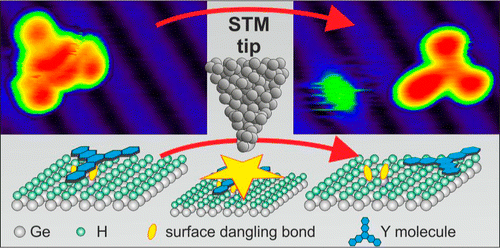Fabrication of single-molecule logic devices requires controlled manipulation of molecular states with atomic-scale precision. Tuning molecule–substrate coupling is achieved here by the reversible attachment of a prototypical planar conjugated organic molecule to dangling bonds on the surface of a hydrogenated semiconductor. We show that the ground electronic state resonance of a Y-shaped polyaromatic molecule physisorbed on a defect-free area of a fully hydrogenated surface cannot be observed by scanning tunneling microscopy (STM) measurements because it is decoupled from the Ge bulk states by the hydrogen-passivated surface. The state can be accessed by STM only if the molecule is contacted with the substrate by a dangling bond dimer. The reversibility of the attachment processes will be advantageous in the construction of surface atomic-scale circuits composed of single-molecule devices interconnected by the surface dangling bond wires.
